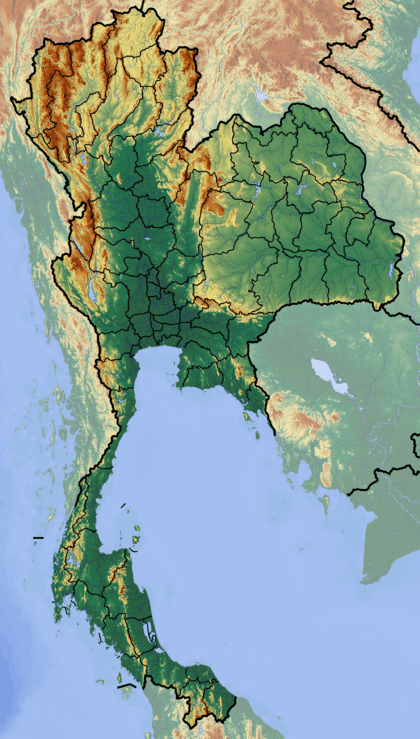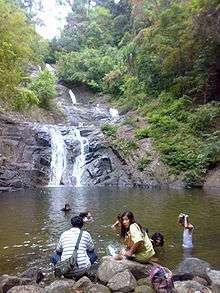Khao Lampi–Hat Thai Mueang National Park
| Khao Lampi–Hat Thai Mueang National Park | |
|---|---|
| อุทยานแห่งชาติเขาลำปี–หาดท้ายเหมือง | |
|
IUCN category II (national park) | |
 Park location in Thailand | |
| Location | Thailand |
| Nearest city | Phang Nga |
| Coordinates | 8°25′22″N 98°14′29″E / 8.42278°N 98.24139°ECoordinates: 8°25′22″N 98°14′29″E / 8.42278°N 98.24139°E |
| Area | 72 km2 (28 sq mi) |
| Established | April 1986 |
| Governing body | Department of National Parks, Wildlife and Plant Conservation |
Khao Lampi–Hat Thai Mueang National Park (Thai: อุทยานแห่งชาติเขาลำปี-หาดท้ายเหมือง) is a national park in Phang Nga Province, Thailand. The park is named for its two separate sections: Khao Lampi named for the park section containing Lampi mountain range and Hat Thai Mueang, the beach section of the park.
Geography
Khao Lampi–Hat Thai Mueang National Park is located in Thai Mueang district, 75 kilometres (47 mi) north of Phuket city and about 60 kilometres (37 mi) west of Phang Nga town. The park lies just off Route 4 (Phetkasem Road).
The park's total area is 72 square kilometres (28 sq mi) and its highest peak is Yot Khao Kanim mountain, in the northern part of the eastern section at 622 metres (2,040 ft).[1][2]
History
Previously known as Lampi Waterfall and Lampi Forest Park, Khao Lampi–Hat Thai Mueang became Thailand's 52nd national park on 14 April 1986.[1]
Attractions

The park is best known for its large waterfalls located in the mountainous eastern section. The largest of these is Ton Phrai Waterfall, 40 metres (130 ft) high and best seen during the rainy season. The park's namesake waterfall, Lampi, is of similar height but lesser volume and falls in numerous tiers.[2]
The Hat Thai Meuang section consists of a pristine 13 kilometres (10 mi) white sand Andaman Sea beach backed by a mangrove forest. A distinguishing feature of the beach (and a prime reason for its protected status) is that it is a sea turtle nesting area. Between November and February sea turtles come to this stretch of beach to lay eggs. In March, a local festival marks when many of the newly hatched baby turtles make their way to the sea.[2][3]
Flora and fauna
The park's eastern section is covered in tropical rainforest, including such tree species as Dipterocarpus, Anisoptera costata, Hopea odorata and bullet wood. Bamboo and rattan are found at lower levels.[1]
In the park's beach section, mangrove forests are found along brackish canals which feed from higher ground into the sea. The mangroves play a protective ecological role in numerous respects including filtration of water from higher ground and providing a sea life nursery. Additionally, the wave energy of the 2004 tsunami was dissipated somewhat by the mangroves in this area.[1]
Further back from the seafront, beach forest is found including such species as Casuarina equisetifolia, Terminalia catappa, Derris indica and Barringtonia.[1]
Swamp forest is also present in this area and is one of the few areas on the Andaman sea coast featuring such an ecosystem.[1]
Mammals include Sumatran serow, Malayan tapir, lar gibbon and Malayan sun bear. palm civet and sambar deer are also found. Turtle species include leatherback, green and hawksbill. Pythons and Malayan pit vipers are also present.[1]
Freshwater fish include rare species such as non-local Nile tilapia, saltwater eel and Hemibagrus wyckii species of catfish. Less rare species such as Nieuhof's walking catfish and blue panchax are also found here.[1][2]
Khao Lampi–Hat Thai Mueang is home to at least 188 bird species, including black-thighed falconet, oriental honey-buzzard, red junglefowl and thick-billed pigeon.[1][2]
References
- 1 2 3 4 5 6 7 8 9 "Khao Lampi - Hat Thai Mueang National Park". Department of National Parks (Thailand). Retrieved 13 April 2013.
- 1 2 3 4 5 "Khao Lampi-Hat Thai Mueang National Park". Tourism Authority of Thailand. Retrieved 13 April 2013.
- ↑ Nam, Suzanne (February 2012). Moon Handbooks Thailand (5th ed.). Avalon Travel. p. 217. ISBN 978-1-59880-969-5.
External links
 Khao Lampi-Hat Thai Mueang National Park travel guide from Wikivoyage
Khao Lampi-Hat Thai Mueang National Park travel guide from Wikivoyage